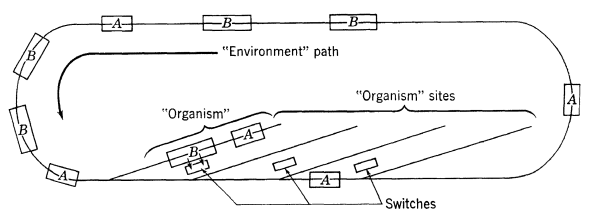
By 1958 many of the attributes of living things could be found in our technology: locomotion (cars), metabolism (steam engines), energy storage (batteries), perception of stimuli (iconoscopes), and nervous or cerebral activity (computers). The missing element was reproduction: We hadn’t yet created a nonliving artifact that could make copies of itself.
So Brooklyn College chemistry professor Homer Jacobson built one. Using an HO gauge model railroad, he designed an “organism” made of boxcars that could use sensors to select other cars on the track and assemble them on a siding into models of itself. “Head” cars have “brains,” and “tail” cars have “muscles” and “eyes”; together, a head and a tail make an organism in which the head directs the tail to watch for available cars elsewhere on the track and shunt them appropriately onto a siding to create a new organism.
“Any new ‘organisms’ formed continue the propagation in a linear fashion,” Jacobson wrote, “until the environment runs out of parts, or there are no more sidings available, or a mistake is made somewhere in the operation of a cycle, i.e., a ‘mutation.’ Such an effect, like that with living beings, is usually fatal.”
(Homer Jacobson, “On Models of Reproduction,” American Scientist, September 1958.)
